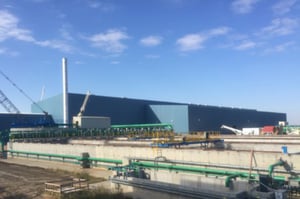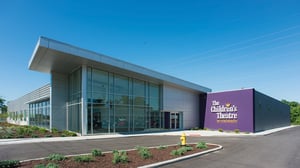When it comes to the natural resources that a building uses, water is always at the top of the list. Some communities across America are particularly challenged either by a lack of resources or failing infrastructure. For example, Phoenix and its surrounding municipalities are in a water-sourcing crisis, while Jackson, Mississippi is dealing with a large water system infrastructure failure leaving over 100,000 people without water. Water is one of the most important resources, and using it sustainably, efficiently, and effectively should be a top priority.
The good news? Water usage is easy to measure, and water efficiency standards are increasing. Water efficiency refers to the responsible use of our water, reducing the overuse and waste of this precious resource. This differs from water conservation in that water conservation usually refers to demand management and reducing water usage, while water efficiency pertains more to technologies and practices that allow people to still use water with reduced consumption.
Innovative water efficiency solutions that manage usage, control flow, and recycle water are becoming more prominent, implemented from the early stages of architecture and design. And there are plenty of solutions that can be used to update buildings and take minimal effort, too!
Water Usage in the U.S.
The latest U.S. Geological Survey (USGS) report estimated water use across the U.S. to be about 322 billion gallons per day (Bgal/d). According to the EPA, “the average American family uses more than 300 gallons of water per day at home,” and “roughly 70% of this use occurs indoors.” This is an enormous amount of water, and while the Earth may seem to have plenty of this resource, less than 1% of that is available for human use.
Waste of the resource itself is not the only environmental impact of using water. Many buildings rely on centralized municipal water supplies, so on the other side of this water usage is the time, money, and energy spent on transporting and retreating this water before it gets recycled back into the system.
Prioritizing efficient water usage is a must, and there are countless other benefits that come along with it. Aside from the money saved from less water being used, water efficiency can also help us maintain our aquatic ecosystems, improve water quality, and mitigate the impacts of drought.
Water-Saving Strategies
Water efficiency features help reduce the overall amount of water used in a building or facility. Where to begin?
At home, it's easy to use less water for teeth brushing or a shower. But when we consider commercial buildings, we need to apply different tactics. There are some general, small changes that can be impactful such as the installation of a water-efficient faucet or the use of a low-flow toilet. When building new, it's always advisable to install water-efficient fixtures from the beginning. Also, larger water-using systems such as irrigation and process water can also be designed efficiently.
Project teams can follow an integrated process to begin assessing existing water resources, opportunities for reducing water demand, and alternative water supplies. Effective strategies include:
- Install submeters to measure baseline flow and reduce usage
- Use gray water or non-potable water whenever possible
- Use green landscaping features such as native plants and/or xeriscaping
- Use water-efficient irrigation strategies and technologies
- Harvest rainwater by installing a rainwater collection system
- Install efficient plumbing fixtures
From an individual feature to a single room to the entire building, every little bit counts. Take a bathroom, for instance. According to the U.S. Department of Energy, “federal law requires tank and flushometer toilets to use no more than 1.6 gallons per flush (gpf) and urinals to use no more than 1.0 gpf.” Urinals almost always use less water than toilets given their design, but it’s important to recognize that older urinals can use up to 5 gpf, far more than most toilets manufactured nowadays. According to the EPA, if “all older, inefficient urinals were replaced, we could save nearly 36 billion gallons annually.”
If your company is considering upgrading your bathrooms with water-efficient appliances, consider also updating signage as well to reflect the inclusivity of all genders. Sustainability and social equity go hand-in-hand, and offering gender-neutral bathrooms is a step towards equality for all employees, regardless of gender expression.
Certifications Can Guide Your Water-Efficient Designs
Saving water saves money, and in the long run, implementing sustainable features that save water saves money, too. Green building certifications like LEED offer many resources to help companies and people get started tracking their baseline consumption and understand the first steps to take, but it’s always important to consult with designers to find the best solutions to meet your project’s water efficiency goals.
 For example, Big River Steel (BRS), the first LEED-certified steel production facility (now owned by U.S. Steel), incorporated innovative wastewater processes into its design. Based upon LEED's calculators (v2009), the buildings on the site were projected to use 729 gallons per day for building use (toilets, sinks, showers). Juxtaposed to its steel production, that number pales in comparison: 3.8 million gallons per day. While BRS used high-efficiency toilets, sinks, and showers to limit its potable water use for the buildings, it also employed a highly efficient process design that saved 31% of process water. In addition to the efficient design, it also returns 634 gallons of water per day to the Mississippi River - in a state that is cleaner than the groundwater (per EPA guidelines).
For example, Big River Steel (BRS), the first LEED-certified steel production facility (now owned by U.S. Steel), incorporated innovative wastewater processes into its design. Based upon LEED's calculators (v2009), the buildings on the site were projected to use 729 gallons per day for building use (toilets, sinks, showers). Juxtaposed to its steel production, that number pales in comparison: 3.8 million gallons per day. While BRS used high-efficiency toilets, sinks, and showers to limit its potable water use for the buildings, it also employed a highly efficient process design that saved 31% of process water. In addition to the efficient design, it also returns 634 gallons of water per day to the Mississippi River - in a state that is cleaner than the groundwater (per EPA guidelines).
 Emerald also recently helped the Children's Theatre of Cincinnati achieve LEED Gold Certification. Thousands of children and families visit the facility each year and when they visit, they learn about its sustainable design elements. One of those design elements is a large stormwater capture system that provides greywater to flush toilets. The system as designed can provide 171% of the annual flush demand as calculated in accordance with the LEED v3 BD+C rating system!
Emerald also recently helped the Children's Theatre of Cincinnati achieve LEED Gold Certification. Thousands of children and families visit the facility each year and when they visit, they learn about its sustainable design elements. One of those design elements is a large stormwater capture system that provides greywater to flush toilets. The system as designed can provide 171% of the annual flush demand as calculated in accordance with the LEED v3 BD+C rating system!
Whether you are renovating, designing new, or looking to improve performance through operations, Emerald is able to model designs and evaluate your current usage to help shape future savings. Let us know how we can help you reach your goals!
Posts by Tag
- Sustainability (171)
- sustainability consulting (143)
- Energy Efficiency (126)
- Utilities (91)
- LEED (87)
- Sustainable Design (69)
- green building certification (59)
- energy audit (46)
- ESG (45)
- construction (43)
- GHG Emissions (36)
- WELL (32)
- carbon neutrality (31)
- net zero (27)
- tax incentives (27)
- costs (26)
- energy modeling (18)
- electric vehicles (17)
- Energy Star (14)
- Housing (14)
- Inflation Reduction Act (13)
- water efficiency (13)
- Social Equity (12)
- decarbonization (12)
- diversity (10)
- NGBS (7)
- fitwel (7)
- Earth Day (6)
- electrification (5)
- mass timber (5)
- non-profit (5)
- retro-commissioning (5)
- Emerald Gives (4)
- Engineering (4)
- News Releases (4)
- B Corp (3)
- COVID-19 Certification (3)
- Customers (3)
- Indoor Air Quality (3)
- PACE (3)
- Arc (2)
- DEI (2)
- EcoDistricts (2)
- EcoVadis (2)
- Green Globes (2)
- cannabis (2)
- CDP (1)
- SITES (1)
- furniture (1)
- opportunity zone (1)
- womenleaders (1)


